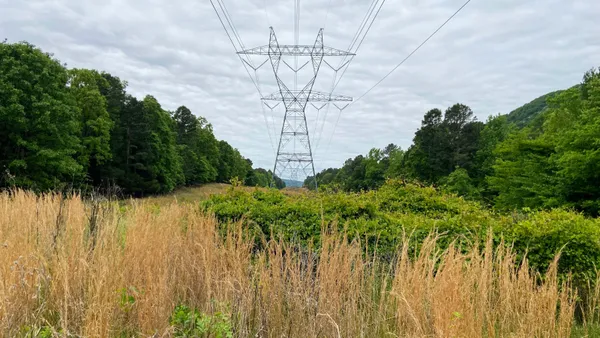Dive Brief:
-
The PJM Interconnection’s plan to open its markets to distributed energy resource (DER) aggregations is a "good first step," but it includes provisions that may prevent them from full market participation, Advanced Energy Economy (AEE) and Advanced Energy Management Alliance (AEMA) said Wednesday.
-
PJM, the largest U.S. grid operator, filed a plan Tuesday at the Federal Energy Regulatory Commission establishing a framework for aggregated DERs like rooftop solar, energy storage and electric vehicle chargers to take part in the grid operator's energy, capacity and ancillary services markets starting in 2026.
-
PJM said it will continue to work on various issues that emerged during stakeholder discussions, such as cybersecurity and making sure the DER aggregation model keeps up with evolving state policy and grid modernization efforts.
Dive Insight:
In a landmark decision, FERC in September 2020 ordered regional transmission organizations and independent system operators to remove barriers keeping DER aggregations from participating in wholesale markets.
Since then, grid operators have been developing plans to meet the requirements FERC laid out in its Order 2222.
FERC’s decision coincided with rapid growth in DERs in response to declining consumer costs, increased consumer interest and state policy, according to Jeff Dennis, AEE managing director and general counsel.
"We're going to have this big set of resources out there that, when aggregated together, can provide valuable services to the wholesale market, and in capturing that value can help make the markets more efficient, and can provide a new, resilient and reliable set of resources for the RTOs," Dennis said Wednesday. "And it's really one of the first steps toward unlocking flexibility on the demand side of the market."
The compliance plan aims to strike a balance between giving aggregated DERs access to the wholesale markets while allowing distribution utilities and "relevant electric retail regulatory authorities" to make sure the electric distribution system is safe and reliable, according to PJM, which operates the grid in 13 Mid-Atlantic and Midwest states and the District of Columbia.
PJM said its DER aggregator participation model accommodates the physical and operational characteristics of an aggregation without placing restrictions on resource or technology types for market participation, and allows both single-type and mixed DER aggregations to participate in all markets where they can provide services. A mixed aggregation could combine different resources such as residential rooftop solar, energy storage and larger, off-site solar, for example.
The proposal defines a DER aggregator as having at least one DER component. The aggregation must be able to provide at least an energy and/or ancillary services market offer of 100 kW, and individual DER components may not exceed 5 MW, according to the filing.
PJM’s "balanced treatment" of various resource types and innovation on metering, submetering and settlement data will help facilitate DER participation in the grid operator’s markets, AEMA said in a statement.
Even so, the alliance and others see areas in the proposal they say may limit DER aggregations.
PJM’s proposal restricts DER aggregation participation in the energy market to a single pricing node on the grid. PJM said allowing aggregations to use multiple nodes would make it hard to meet reliability standards. The grid operator proposed allowing multi-nodal aggregations of up to 5 MW for its capacity and ancillary services markets.
The limit to a single node makes it challenging to create DER aggregations and could strand potential resources, according to Greg Geller, head of regulatory affairs for Enel North America. Ideally, an aggregation is as large as possible, which may require covering a wide area, he said Wednesday.
Enel manages aggregations of electric vehicle chargers in markets run by the California Independent System Operator (CAISO) and is interested in bringing them to other markets, Geller said.
PJM has thousands of nodes so meeting a 100-kW minimum size for an aggregation may be difficult, according to AEMA. "By comparison, California, New England, and New York all found ways to allow for these smaller resources to participate by allowing aggregation over large subsets of pricing nodes," the trade group said in a statement.
AEE is also concerned about PJM's proposed registration process for aggregations. Under the plan, DER aggregations must coordinate with their distribution utility before registering with PJM. The registration process includes a 60-day period for distribution utilities to review the proposed aggregation. After getting the utility’s recommendation, PJM has 15 days to approve or reject the registration.
The proposed registration process could effectively give distribution utilities veto power over planned aggregations, according to Prusha Hasan, AEE policy principal.
The trade group is also concerned about limits on participation by net energy metered resources in energy and capacity markets, which would leave a "swath" of resources unable to be a part of PJM’s markets, Hasan said.
While AEE would like to see some changes to PJM’s proposal, it appears to meet the needs of potential DER aggregators better than other grid operator plans, including ISO New England’s proposal filed Wednesday, according to Dennis.
"Our members were happier with PJM's proposal than some of the other ones we've seen," Dennis said. "Like in New England, we don't think New England's proposal will unlock really anything."
FERC is reviewing Order 2222 compliance filings from CAISO and the New York Independent System Operator. The Midcontinent Independent System Operator and the Southwest Power Pool are preparing to file their proposals this spring.














